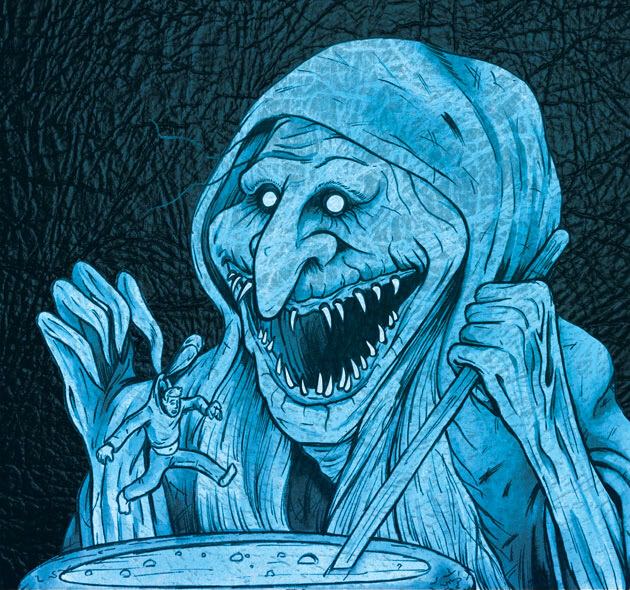 Submitted by Storyteller on
Submitted by Storyteller on

Imgur.com
While Krampus may be king of holiday scares, his fans may be overlooking an equally nasty, much more formidable queen—a Christmas monster who lives further north, in the frigid climes of Iceland who goes by the name Grýla, the Christmas witch. This tough ogress lives in a cave in Iceland’s hinterlands, the matriarch of a family of strange creatures, launching attacks on nearby townships, snatching up misbehaving children, and turning them into delicious stew.
“You don’t mess with Grýla,” says Terry Gunnell, the head of the Folkloristics Department at the University of Iceland. “She rules the roost up in the mountains.”
Tales of the ogress began as oral accounts, with the earliest written references found in the 13th century, in historic sagas and poems throughout the region. One reads, “Here comes Grýla, down in the field, / with fifteen tails on her,” while another describes, “Down comes Grýla from the outer fields / With forty tails / A bag on her back, a sword/knife in her hand, / Coming to carve out the stomachs of the children / Who cry for meat during Lent.”
In Iceland, the midwinter holiday known as jól—a version of the Old English and Old Germanic word Yule, which describes this time of gathering together, feasting and celebrating and which evolved into modern Christmas—is generally darker than in the U.S. (and not just because the sun barely comes out during that time of year). According to Gunnell, the earliest celebrations of the season were viewed as a time not only to bring together relatives, living and deceased, but also elves, trolls and other magical and spooky creatures believed to inhabit the landscape. Sometimes these figures would visit in the flesh, as masked figures going around to farms and houses during the season.
Grýla, whose name translates loosely to “growler,” would be among these, showing up with a horned tail and a bag into which she would toss naughty children.
“She was certainly around in about 1300, not directly associated with Christmas, but associated with a threat that lives in the mountains. You never knew exactly where she was,” says Gunnell. Long poems were written about her and a husband, but he didn’t last long, as Gunnell explains. “She ate one of her husbands when she got bored with him. In some ways, she’s the first feminist in Iceland.”
Other bits of folklore describe a second, troll-like husband and a giant man-eating Yule Cat known to target anybody who doesn’t have on new clothes—making a new pair of socks or long underwear an imperative for any Icelandic holiday shopper. Filling out what Gunnell calls “this highly dysfunctional family” are Grýla’s mob of large, adult sons: the 13 Yule Lads.
Each of these troublemakers visits Icelandic households on specific days throughout December, unleashing their individual types of pestering—Hurðaskellir is partial to slamming doors, Pottaskefill eats any leftovers from pots and pans, and Bjúgnakrækir lives up to his nickname of "sausage swiper."
Grýla did not get connected to Christmas until around the early 19th -century, when poems began to associate her with the holiday. It was also about this time when the Yule Lads and Yule Cat—which had been standalone Christmas characters with no connection to the Christmas witch—then became part of her big creepy family.
Prior to that, she was “really a personification of the winter and the darkness and the snow getting closer and taking over the land again,” according to Gunnell. Not only did she represent the threat of winter, she was seen as actually controlling the landscape. Gunnell explains that the Icelandic people understood themselves to be more like tenants of their harsh environment (where glaciers, volcanoes, and earthquakes dominate), and would view mythical creatures like Grýla as the ones who were really running the show. Krampus only wishes he had such power.
“Grýla is the archetypal villain, and the fact that she’s a matriarch makes her somehow more frightening,” says Brian Pilkington, an illustrator who has drawn some of the definitive depictions of Grýla and the Yule Lads.
In the 20th century, as American Christmas and its depiction of Santa Claus proliferated through Europe and beyond, attempts were made to “Santafy” the Yule Lads. Their bellies widened, their troll-like whiskers grew a bit bushier, and they acquired red-and-white fur costumes. They also, like Santa, began leaving gifts rather than taking sausages, snacks, and so on. (The Dutch tradition of children leaving out their shoes to find chocolates and treats the next morning also influenced this shift.) Some critics tried to snuff out Grýla altogether, attempting to sideline the scary character with more family-friendly fare; one popular Christmas song describes her death.
In more recent years, Iceland as a whole, led by the National Museum of Iceland, have worked to return the Yule Lads to their pre-Santa roots, “trying to get them dressing in 17th- and 18th- century ragged clothes, bringing them back to the browns and the blacks—the local wool colors,” as Gunnell puts it, “looking like aged Hell’s Angels without bikes.” The characters appear in person, with adults dressing up like them to entertain and sing with the children who visit the National Museum.
“It’s a little bit like hanging on to the language and traditions of that kind, to avoid the global Santa image, even if it has the same roots to the past, they’d rather hang on to their Icleandic version,” says Gunnell.
Pilkington, working alongside the National Museum, has worked to do this in his illustrations, including The Yule Lads: A Celebration of Iceland’s Christmas Folklore, a kids’ book about the characters that is ubiquitous around Iceland during the holidays, in both English and Icelandic.
Likewise, Grýla has proven a tough figure to dislodge, with her likeness found throughout the capital city of Reykjavik and beyond, sometimes in the flesh.
“Children are truly terrified of Grýla in Iceland,” says Pilkington. “I’ve visited children's playschools to demonstrate drawing skills and if I draw Grýla then two or three terrified children have to leave the room because it’s too strong for them. This is living folklore.”
Gunnell agrees: “She’s never stopped being embraced here,” he says. “As a living figure, you see her all around Reykjavik. She’s never really gone away.”
Alex Palmer
- 1398 reads